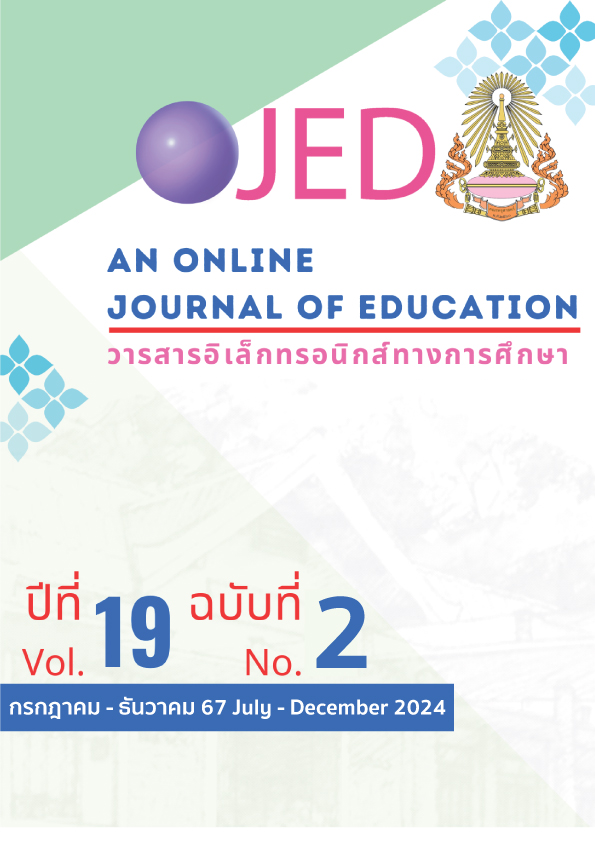Using the Internet System for Online Learning of Undergraduate Student Faculty of Education Sakon Nakhon Rajabhat University
DOI:
https://doi.org/10.14456/ojed.2024.6Keywords:
Online learning, Internet System, Undergraduate studentAbstract
The objectives of this research were to Study the use of the Internet system. Opinions on the use of the Internet and problems in online learning of undergraduate students. The sample used in the research was undergraduate students from the Faculty of Education, Sakon Nakhon Rajabhat University. Currently studying in the first semester of academic year 2022, a total of 361 students are randomly selected in multiple stages. The tools used in the research are questionnaires. The data were analyzed by breaking down the frequency, determining the percentage, mean, standard deviation and content analysis. The results showed that: 1) The use of the Internet system for online learning of students is mainly incurred. Experience in using the Internet and often speaking Thai. The use of the Internet for education is very high (M = 3.90, SD = 0.33) and the use of the Internet for research is very high (M = 3.93, SD = 0.38). 2) Students' opinions on the use of the Internet in online learning. It was found that the university's internet system was not as smooth as it should affect online learning. Some lecturers do not have online teaching preparation and the space on campus is not enough to use the Internet and 3) Problems in using the internet for online learning. The server computer is inefficient, there are frequent delays, English is also a barrier for students to use the Internet, and some instructors do not pay attention to online learning.
References
ภาษาไทย
กาญจนา บุญภักดิ์. (2563). การจัดการเรียนรู้ยุค New Normal. วารสารครุศาสตร์อุตสาหกรรม, 19(2), A1-A6.
กระทรวงการอุดมศึกษา วิทยาศาสตร์ วิจัยและนวัตกรรม. (2564). มาตรการและการเฝ้าระวังการระบาดของ โรคติดเชื้อไวรัสโคโรนา 2019 (COVID-19) (ฉบับที่ 16). กระทรวงการอุดมศึกษา วิทยาศาสตร์ วิจัยและนวัตกรรม. https://www.mhesi.go.th/images/Pusit2021/pdfs/16-AnnCovidE.pdf
ประสาท เนืองเฉลิม. (2557). อินเทอร์เน็ตเพื่อการเรียนรู้. กรุงเทพฯ: สำนักพิมพ์โอเดียนสโตร์.
พงศธร สิทธิจันทร์, อนุสรา นิลวัลย์, และ สมิตา กลิ่นพงศ์. (2564, พฤษภาคม). ทัศนคติต่อการเรียนออนไลน์ของนักศึกษาชั้นมัธยมศึกษาปีที่ 6 จังหวัดจันทบุรีในช่วงการแพร่ระบาดโรคโควิด-19 [Paper presentation]. การประชุมผลงานการวิจัยและวิชาการนวัตกรรมธุรกิจและการเป็นผู้ประกอบการ ครั้งที่ 8 สาขาบริหารธุรกิจ มหาวิทยาลัยรังสิต, ปทุมธานี, ประเทศไทย.
มารุต พัฒผล. (2563). การประเมินการเรียนรู้ใน New Normal. กรุงเทพฯ: สำนักพิมพ์มหาวิทยาลัยศรีนครินทรวิโรฒ.
วิชัย วงศ์ใหญ่ และ มารุต พัฒผล. (2563). การออกแบบการเรียนรู้ใน New Normal. กรุงเทพฯ: สำนักพิมพ์มหาวิทยาลัย
ศรีนครินทรวิโรฒ.
วัฒนพร จตุรานนท์. (2563). การศึกษาพฤติกรรมการเรียนออนไลน์และความพึงพอใจที่มีต่อการจัดการเรียนรู้ภาษาจีนผ่านระบบออนไลน์ ของนิสิตหลักสูตรการศึกษาบัณฑิตสาขาภาษาจีน คณะศึกษาศาสตร์ มหาวิทยาลัยบูรพา. วารสารวิชาการภาษาและวัฒนธรรมจีน มหาวิทยาลัยหัวเฉียวเฉลิมพระเกียรติ, 7(2), 291-310.
ศิริชัย กาญจนวาสี. (2556). ทฤษฎีการทดสอบแบบดั้งเดิม. กรุงเทพฯ: โรงพิมพ์แห่งจุฬาลงกรณ์มหาวิทยาลัย.
สริตา เจือศรีกุล, อำไพ ตีรณสาร, ธนวรรณ เจริญภัทราวุฒิ, ณัฐพล ศรีใจ, มรุต มากขาว, วนาลี ชาฌรังสี, สุภาพรรณ วงศ์ศักดิ์ศิริกุล, สุภัญญา สมทา, และ อริสรา วิโรจน์. (2563). แนวทางการจัดการเรียนการสอนศิลปะปฏิบัติออนไลน์ในสถานการณ์ฉุกเฉิน: กรณีศึกษาสถานการณ์โควิด 19. วารสารครุศาสตร์สาร, 14(2). 99-114.
ภาษาอังกฤษ
Barron, A. E., & Ivers, K. S. (1996). The Internet and Instruction: Ideas and Activities. Englewood. Libraries Unlimited.
Bahman, Y. S., Azam, A., Tayebe, G., Fatemeh, H. B., & Jaber J. (2014). A Survey of Amount of Internet Usage Among High School Students of Khadr Country and its Impacts on Student. Online Information Review Science Direct Procedia – Social and Behavioral Sciences, 114(2), 610-616.
Cronbach, L.J. (1951). Coefficient Alpha and the Internal Structure of Tests. Psychometrika, 16(2), 297 – 334.
Tuncer, M. (2013). Vocational School Students’ Attitudes Towards Internet. Science Direct Procedia – Social and Behavioral Sciences, 103(2). 1303-1308.
Mohammadi, N., Ghorbani V., & Hamidi F. (2011). Effects of E-learning on Language Learning. Science Direct Procedia Computer Sciences, 3(1). 464 – 468. https://doi.org/10.1016/j.procs.2010.12.078
Vasilis, G., Kleopatra, N., & George, K. (2013). Student Teachers’ Perception about the Impact of Internet Usage on Their Learning and Jobs. ELSEVIER Computer & Education, 62(1). 1–7.
Vught, F. V. (1997). Information Technology: The Next Step in the Development of Academic Institutions. In NUFFIC Seminar on: Virtual Mobility: New Technologies and Internationalization. Jossey-Bass.
Teena, W., S. Alexandria, A., Eileen, W., Julie, M., & Craig, R. (2009). Fast Searching for Information on the Internet to use in a Learning Context: The Impact of Domain Knowledge. ELSEVIER Computer & Education, 52(2). 640-648.
Yamane, T. (1973). Statistics: An Introductory Analysis (2nd ed.). New York: Harper and Row.
Downloads
Published
How to Cite
Issue
Section
License
Copyright (c) 2024 An Online Journal of Education

This work is licensed under a Creative Commons Attribution-NonCommercial-NoDerivatives 4.0 International License.




